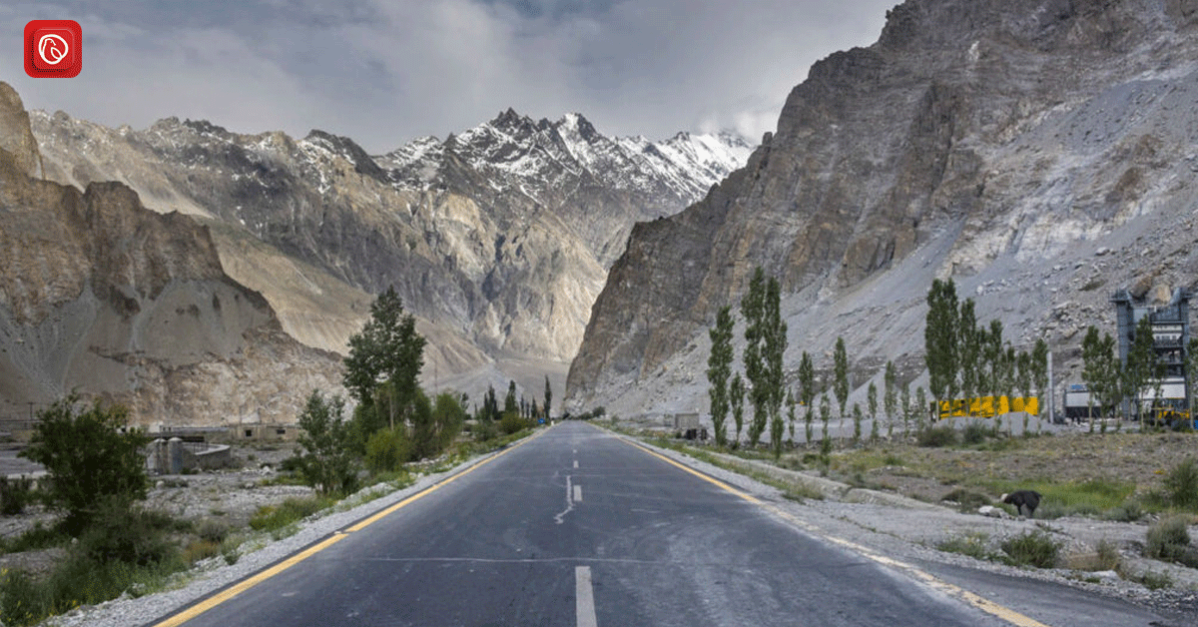Also known as the “Eighth Wonder of the World,” Karakoram Highway has captured the hearts of adventure enthusiasts and independent travellers alike. It offers a one-of-a-kind journey through landscapes of unparalleled beauty. In this blog, graana.com invites you to join us on an exploration of the wonders that await along the Karakoram Highway, an adventure that promises to be nothing short of extraordinary.
Some Facts and Figures
|
Aspect |
Information |
| Length of Karakoram Highway |
1,300km (800 miles) |
|
Cities Connected by the Highway |
Hasan Abdal (Pakistan) and Kashgar (China) |
| Construction Period |
1959 to 1979 (officially opened in 1978) |
|
Khunjerab Pass |
Open only between May 1st and December 31st due to heavy snow. |
| Total Workers Involved in Construction |
Over 24,000 Pakistani and Chinese workers. |
|
Construction Duration |
Nearly 20 years to complete. |
| Worker Casualties |
810 Pakistani and 82 Chinese workers lost their lives during construction, mainly due to landslides and falls. |
|
Landslide Incident in 2010 |
A part of the road submerged in the Hunza Valley. |
| Attabad Lake Tunnel |
Constructed in 2015, consisting of 5 tunnels, 2 bridges, 78 culverts, with a total length of 24 km. Cost: $275 million. |
Geography and Location of the Karakoram Highway
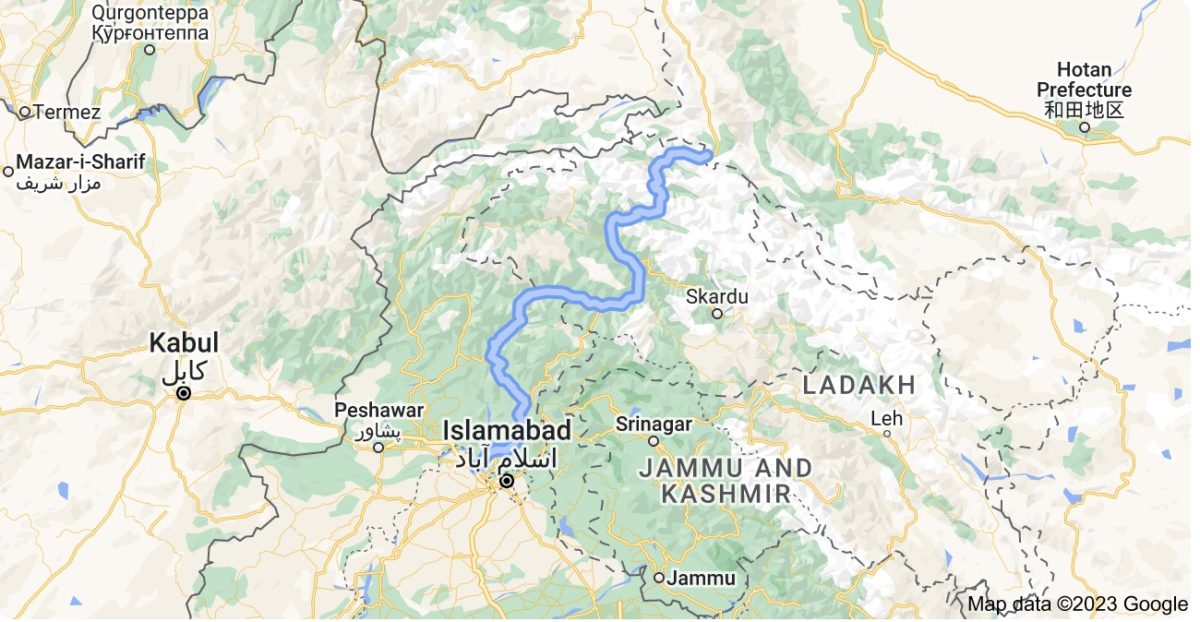
The Karakoram Highway, often called the “8th wonder of the world,” is an extraordinary engineering achievement stretching 1,300 kilometres (800 miles). It connects Hasan Abdal in Pakistan to Kashgar in China, making it a crucial cross-border route.
Notably, it ranks among the world’s highest paved international roads, reaching elevations of up to 4,714 metres at the Khunjerab Pass. This offers stunning vistas and unique challenges like extreme weather conditions, rockfalls, and narrow sections.
The highway’s diverse terrain includes arid deserts, lush valleys, and snow-capped mountains, with varying climates, creating a dynamic landscape for travellers. It cuts through three iconic mountain ranges: the Himalayas, the Karakoram, and the Hindu Kush. It offers breathtaking views of towering peaks like Nanga Parbat, standing at 8,000 metres.
One of the Most Dangerous Roads
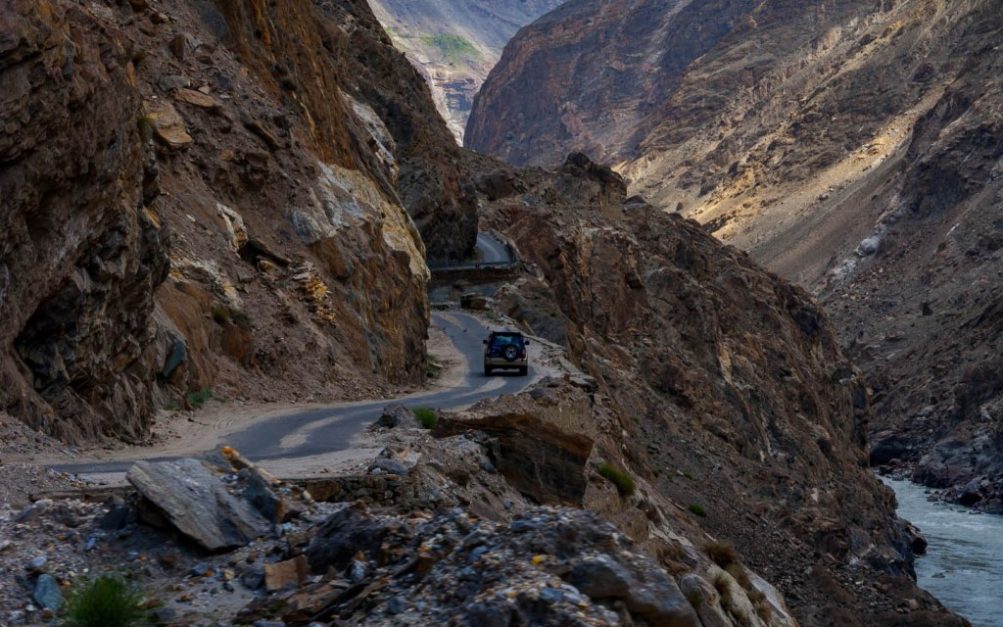
The world’s highest paved international road, although breathtaking, poses a multitude of hazards. This route is frequently battered by falling rocks, landslides, floods, and seismic activity. If you plan to traverse it, using a stone calculator can help estimate the weight of bulk materials you might need for the journey.
Many regard this road as one of the most frightening in the world, and for good reason. It’s a challenging drive and not recommended for standard cars; a 4×4 vehicle is the preferred choice. Venturing along this route in a vehicle ill-equipped to handle its demanding conditions is inadvisable. The road’s treacherous nature demands a vehicle capable of navigating one of the world’s most unforgiving terrains.
Safety should be a top priority, as this mountain road is riddled with hairpin curves and the potential for steep drops on one side. On the other side it boasts a highly unstable mountain with a risk of rockfalls, especially during rainy conditions.
With no protective barrier on one side and sheer rock walls on the other, there is very little room for driver error. Additionally, the area is prone to floods and landslides, so it’s wise to be prepared with equipment like a winch rope, especially if you have passengers who fear heights.
The road’s narrowness, in some sections, allows for only one vehicle to pass at a time, with the other waiting on the precarious edge of the road.
History and Background
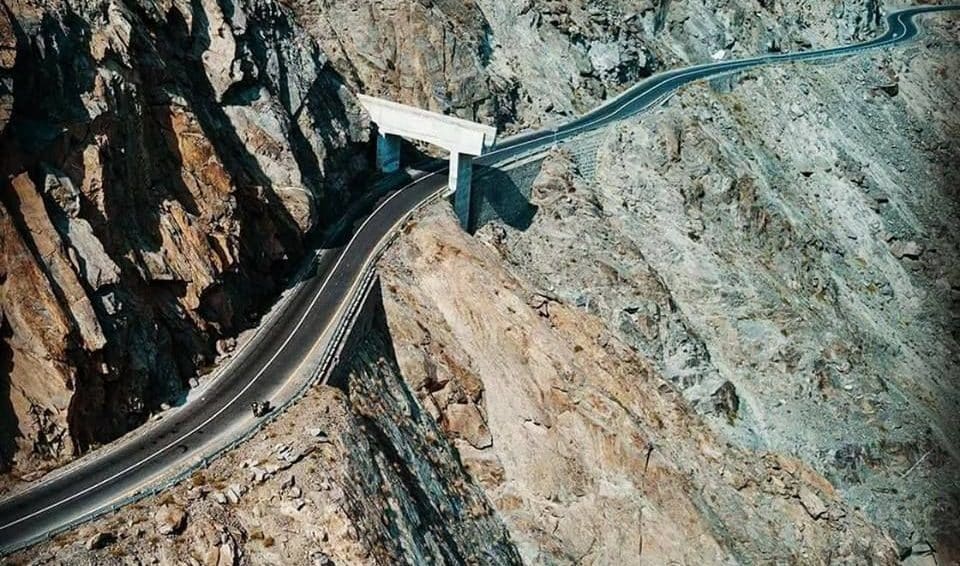
The Karakoram Highway, located in the western part of the Himalayan region, has a rich history. Originally, it served as a caravan route, a branch of the ancient Silk Road, facilitating trade and cultural exchange between the Indian subcontinent and China.
Before this, the route was used by the Mongols during their extensive empire, and they referred to it as the “black range.” Later, the Mughal Empire, which ruled India for many centuries, also made use of this important passage.
The historical significance of the Karakoram Highway is captivating. It was an essential component of the Silk Route, an expansive network of trade routes covering a distance of 6,400 kilometres. This network operated from the 2nd century B.C. to the 14th century A.D., playing a crucial role in fostering economic, cultural, and political connections between the East and the West.
Construction of the Karakoram Highway, also known as the Friendship Highway. Commenced in 1959, it was a collaborative effort involving Pakistani and Chinese engineers and workers. However, it took nearly two decades to complete this substantial project.
Throughout its history, the Karakoram Highway has maintained its significance, not only because its the world’s highest international road but also due to its passage through three of the world’s largest mountain ranges, serving as a vital trade route connecting the Indian subcontinent and China.
Eighth Wonder of the World
The Karakoram Highway (KKH) is rightfully celebrated as the “Eighth Wonder of the World,” and there are several compelling reasons for this prestigious title. This engineering marvel traverses some of the most challenging and perilous terrain on our planet, making it an exceptional feat of human achievement.
High Altitude
The KKH is renowned for its lofty altitude, ranking among the highest paved international roads globally. It ascends to an astonishing 4,714 metres (15,466 ft) at the Khunjerab Pass, taking travellers through some of the Earth’s most rugged and remote landscapes.
Engineering Marvel
Constructed between 1959 and 1979, the KKH stands as a testament to human ingenuity and determination. The joint Pakistani-Chinese team of engineers and workers faced formidable challenges during its construction.
They had to carve the road out of sheer rock faces, span turbulent rivers, and even blast through glaciers, all under extreme conditions. The construction process came at a high human cost, with over 800 workers making the ultimate sacrifice. However, their dedication and sacrifice paved the way for one of the world’s most iconic roads.
Stunning Scenery
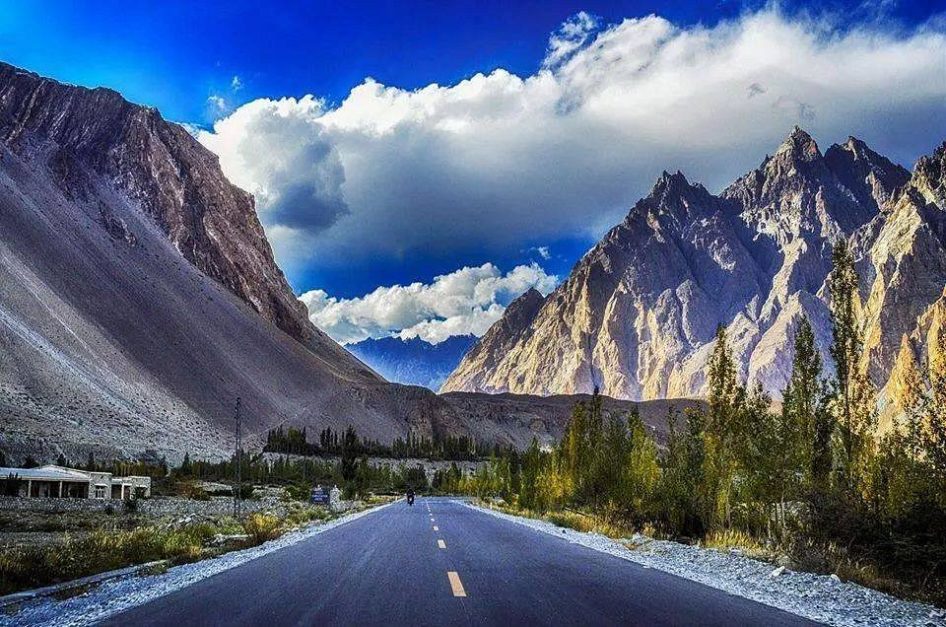
The KKH weaves through breathtaking landscapes, offering travellers the chance to witness towering mountains, majestic glaciers, and verdant valleys. The road’s surroundings are a showcase of nature’s grandeur, providing an unparalleled scenic experience.
Cultural Significance
Beyond its engineering prowess and natural beauty, the KKH plays a pivotal role in connecting people from diverse cultures and religions. It serves as a vital trade and transportation corridor between Pakistan and China, contributing to the region’s economic development and growth.
Moreover, it has become a popular tourist destination in north Pakistan, drawing adventurers and explorers from around the world to immerse themselves in its unique blend of culture and nature.
In essence, the Karakoram Highway is more than just a road. It symbolises the indomitable human spirit and serves as a reminder that remarkable achievements are possible through unwavering determination and hard work.
This iconic highway stands as a testament to human ingenuity and remains an enduring wonder that captures the imagination of all who traverse its challenging but awe-inspiring path.
A Tourist Attraction for Adventure Seekers
The Karakoram Highway (KKH) spans 1,300 kilometres, connecting Pakistan and China via the magnificent Karakoram Mountains. As one of the world’s highest paved roads, the KKH reaches an elevation of 4,714 metres at the Khunjerab Pass, making it an enticing destination for adventurers.
This iconic highway serves as a haven for thrill-seekers, offering a backdrop of breathtaking natural beauty and a wide array of activities to satisfy their adventurous spirits. Here, you can immerse yourself in heart-pounding pursuits such as hiking, mountain biking, white-water rafting, rock climbing, and camping.
Beyond these adrenaline-pumping adventures, the KKH also provides unique opportunities for cultural exploration. Travellers can visit local villages and towns to gain insights into the rich tapestry of local culture and customs, as well as savour traditional Pakistani cuisine.
For adventure enthusiasts, the Karakoram Highway is a must-visit destination. It offers a fusion of natural grandeur and the excitement of diverse activities, making it an ideal place to test your limits and embrace the spirit of adventure.
Following are some practical tips for planning your KKH adventure:
- Optimal Time to Visit: Consider planning your trip during the summer months, from May to September, when the weather is relatively mild, and the roads are typically open.
- Weather Preparedness: Be ready for changing weather conditions, as mountain weather can be quite unpredictable.
- Provisions: Ensure you have an ample supply of food and water, as amenities along the highway may be limited.
- Local Guidance: If you intend to engage in hiking, mountain biking, or white-water rafting, think about hiring a knowledgeable local guide to navigate the terrain.
- Altitude Awareness: Given the high altitude, stay vigilant for potential altitude sickness and take regular breaks to acclimatise.
FAQs
Following are a few FAQs on Karakoram highway:
What is the Karakoram Highway (KKH)?
The Karakoram Highway, often referred to as the KKH, is a 1,300-kilometre (800-mile) road. It connects Pakistan and China through the stunning Karakoram Mountains. It is known for being one of the highest paved roads globally, with its highest point at the Khunjerab Pass, which is at an elevation of 4,714 metres.
What are the main attractions along the Karakoram Highway?
The KKH offers a wide range of attractions and activities for travellers. Some of the main attractions include breathtaking mountain scenery, opportunities for hiking, mountain biking, white-water rafting, rock climbing, camping, and cultural experiences in local villages and towns. Travellers can also savour traditional Pakistani cuisine.
When is the best time to visit the Karakoram Highway?
The best time to visit the KKH is during the summer months, typically from May to September. During this period, the weather is relatively mild, and the roads are more likely to be open for travel.
How should I prepare for a journey on the Karakoram Highway?
Travellers should be prepared for varying weather conditions, as mountain weather can change rapidly. It’s important to bring ample provisions, including food and water, as amenities along the highway may be limited.
If you plan on engaging in adventure activities, consider hiring a local guide who is familiar with the terrain and be aware of the potential for altitude sickness at high elevations.
The Karakoram Highway (KKH) is a renowned 1,300-kilometre road that links Pakistan and China through the stunning Karakoram Mountains. Known for its breathtaking mountain scenery and extreme elevation, it offers adventure seekers opportunities for hiking, mountain biking, white-water rafting, and cultural exploration. The KKH is an iconic destination for those who seek thrilling experiences amidst the natural splendour of the Karakoram Mountains.
This was all about the Karakoram highway. For more information, visit Graana.com.
